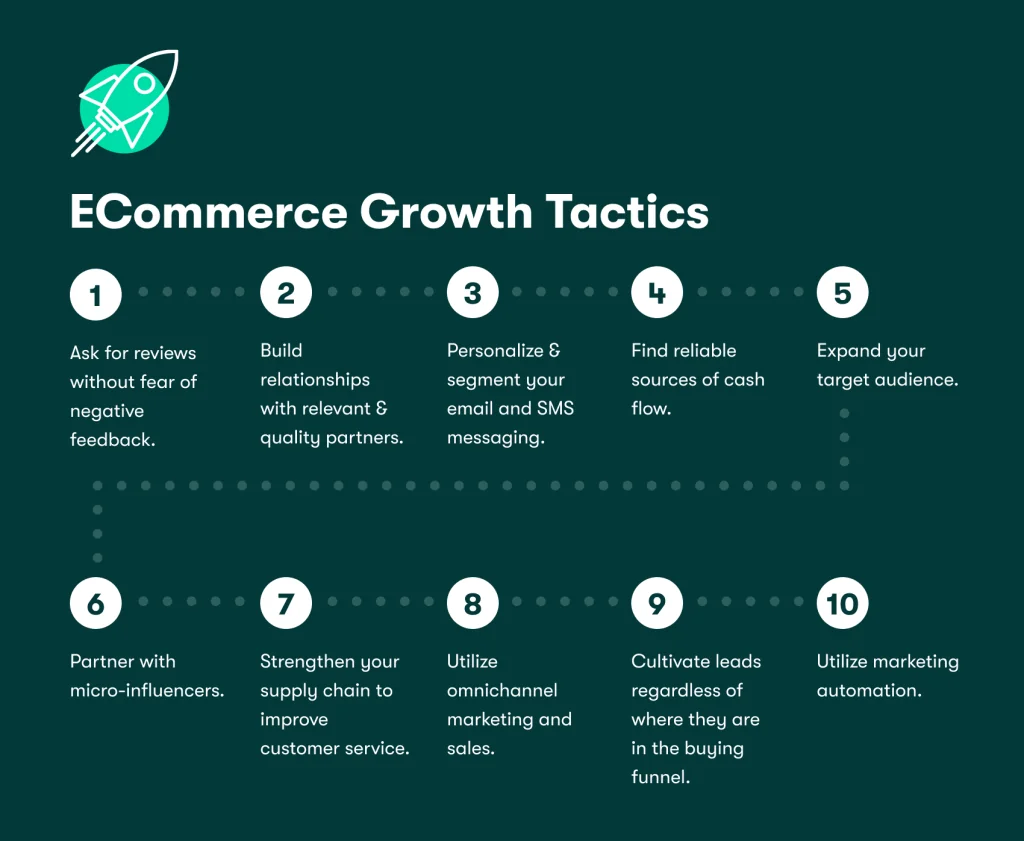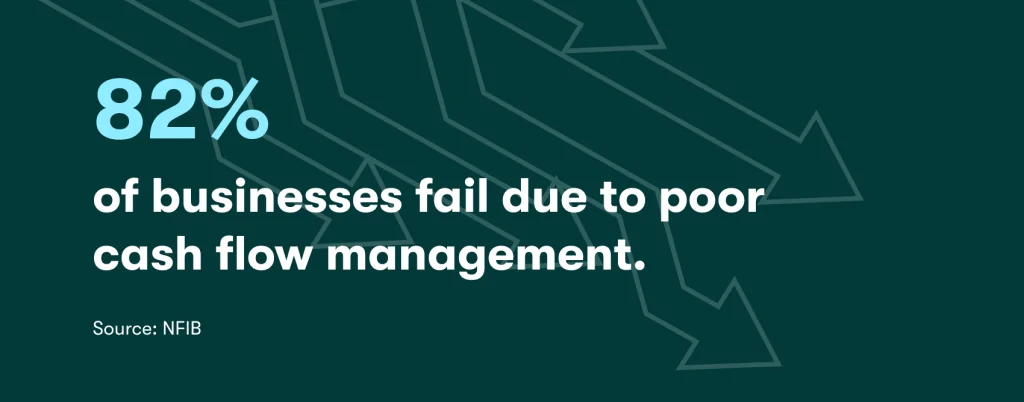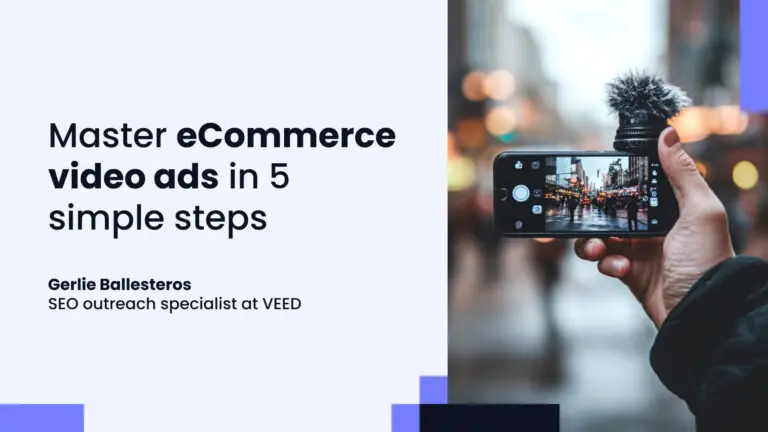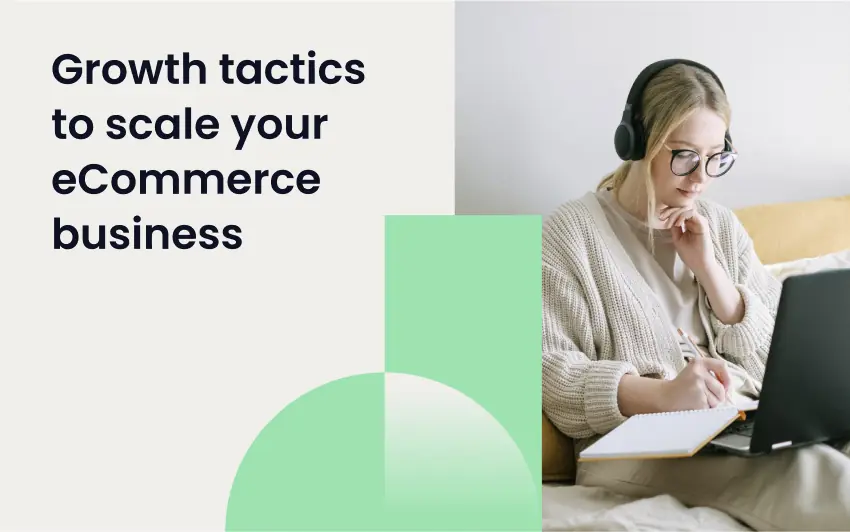- Build Trust with Customer Reviews
- Pursue Relevant Partnerships
- Personalize Marketing Emails and Text Messages
- Secure Continuous Cash Flow
- Expand Your Target Market
- Utilize Micro-Influencers
- Focus on Customer Service
- Consider an Omnichannel Strategy
- Nurture Leads in Every Stage of the Funnel
- Trigger Marketing Automation Messaging
- Accelerate Your Path to Growth in 2023
The COVID-19 pandemic caused shoppers to move online faster than ever before, giving eCommerce and extra boost of $183 billion. That staggering number results from more than 266 million digital buyers seeking the variety and convenience of online shopping. We’ll walk you through how to grow your eCommerce business while addressing the unique challenges eCommerce sellers face today, so this can be your most profitable year yet.
While consumer demand is higher than ever, eCommerce sellers are still facing unique challenges as a result of the COVID-19 pandemic and supply chain crisis. Because of this, the strategies that got your business where it is won’t be what get it to the next level. Your marketing and operations must evolve to remain relevant in an ever-changing retail landscape. Keep reading to discover 10 tactics for online store growth

1. Build Trust with Customer Reviews
Did you know that 95% of shoppers read online reviews before making a purchase? Reviews are an essential part of building trust and differentiating yourself from the competition.
If someone can see feedback from at least five real customers, they’re 270% more likely to purchase than if there are no reviews.
And while positive reviews are preferred, there are benefits to having some negative responses in the mix. Critical feedback gives you valuable information on improvements to your products and the user’s experience, while also giving you a chance to respond and strengthen relationships with customers.
Negative reviews can also make you appear more credible. There is skepticism among online buyers, meaning too many five-star ratings may lead to doubt in the authenticity of your reviews. Research conducted by Northwestern University has found that sales peak when ratings are between 4.0 and 4.7.
To encourage reviews:
- Make sure you’re on product and business review sites, such as Google My Business, Amazon, Trustpilot, and Influenster.
- Proactively request reviews from customers, making it simple by sending direct links to your preferred review site.
- Monitor feedback and respond appropriately, taking action when needed to improve your customer’s experience.
2. Pursue Relevant Partnerships
Many key players ensure your business can fulfill orders, whether they’re internal or external partners. You must have reliable capital, quality suppliers, a comprehensive eCommerce platform, effective marketing, trustworthy shipping, and data you can trust to inform your decisions — to name a few.
Subscribe to the eCommerce newsletter for
top industry insights
Finding partners you can build relationships with will give you a leg up when interruptions occur. Suppose an employee shortage impacts the warehouse that stores your product. You’ll want to have a strong relationship with their team to get prompt responses and a clear understanding of the impact on your own supply chain.
Vet your partners to ensure they can deliver quality, communication, and results.
3. Personalize Marketing Emails and Text Messages
Personalized marketing messages help your communications stand out in a customer’s inbox. Emails with personalized subject lines are 26% more likely to be opened than generic subject lines and can easily be executed using personalization tags based on subscriber field data.
But personalization goes beyond referring to the customer by name. Segmenting your marketing list based on customers’ demographics, interests, or past purchases has a significant impact. Marketers note a 760% increase in revenue when utilizing segments.
Both email and SMS marketing have benefits for promoting online products. While text messages offer a significantly higher open and engagement rate than email, there are character limitations. Text messages are best for single product promotions, asking for reviews, or subscribing to loyalty programs.
Email is the most cost-effective option but often has lower click-through and open rates than text messages. Utilize email for promoting multiple products, newsletters, and company announcements.
We recommend both email and SMS marketing, but personalization is the real key. 91% of consumers are most likely to purchase from companies who make relevant offers and recommendations, so collecting and analyzing your data to send conversion-friendly messaging is critical.
4. Secure Continuous Cash Flow
Profit is often considered one of the strongest indicators of a successful business, but healthy cash flow is just as, if not more, critical. Did you know that 82% of small businesses fail because of poor cash flow management? Without sufficient cash, you can’t invest in your company to achieve substantial growth.
This is especially true in eCommerce, when payouts to multiple stops in your supply chain occur every time you restock products. Many online sellers find that even if products experience high demand, they can’t scale their orders without a significant increase in cash flow.
Finding a funding partner that understands the dynamic nature of eCommerce is essential. A strong cash flow also allows you to pay yourself, your employees, and your partners on time, strengthening your professional relationships and reputation within the eCommerce space.
An activated 8fig Growth Plan may fund up to 90% of your hero product’s supply chain. This frees you up to invest revenue in other areas of your business, such as new product research and expansion.

5. Expand Your Target Market
Your target market should be identified through thorough research and testing, allowing you to focus your budget and marketing on the individuals most likely to buy. Once you’ve proven you can successfully sell to a specific target, it’s time to look for ways to expand.
Potential expansions include new markets, new products, or new demographics. Assess your competition and deep dive into analytics to determine which customers to pursue next.
If you decide on a new audience, it’s essential to evolve your messaging to appeal to them without losing what’s working with your current clientele. This is where segmentation and personalization become critical. Imagine a company selling percussive therapy devices to athletes has made the decision to target individuals with chronic muscle pain. They will need to create messages and provide offers that resonate with both groups.
6. Utilize Micro-Influencers
ECommerce sellers commonly promote their products through influencers with followers that trust their recommendations. However, partnering with more prominent content creators can be difficult, as it’s competitive and pricey. Consider targeting micro-influencers that appeal to more niche markets, are more cost-effective, and are willing to partner.
Mirco-influencers are creators with anywhere from 10,000 to 250,000 followers. They’re typically considered more trustworthy and have higher engagement rates as they’re more relatable to everyday people. Depending on their following, they may be willing to promote your business in exchange for product or ask for additional payment. Make sure you agree on the number of posts, stories, and links, so everyone is clear on what to expect.
Micro-influencers are capitalizing on the power of social media. Ecommerce businesses can partner with them to benefit from top trends.
- The hashtag #tiktokmademebuyit has over 7 billion views.
- Hashtags such as #shopsmall and #sustainablefashion will remain popular in 2023, giving small eCommerce businesses a channel for promotion.
- There are influencers who specialize in promoting products specifically from marketplaces, such as Walmart and Amazon. If you sell on these platforms, these content creators make great partners.
Facebook, which used to hold the title of top social channel, faces public scrutiny on top of ever-growing competition. If your social media budget focuses on this channel only, it’s a good time to diversify your online presence. Monitor social trends to stay prominent and relevant.
7. Focus on Customer Service
Providing exemplary customer service may seem like a no-brainer, but a positive buying experience starts well before your initial interaction with a buyer. You must have inventory available for purchase and logistics partners to get packages to doorsteps quickly. So, while you must be accessible, responsive, and helpful in your communication, you need to think through your entire supply chain to ensure the best experience for your customers.
Two of the top customer complaints are long delivery lead times and items being out of stock. Stockouts not only stop the initial purchase but prevent you from making exchanges rather than returns when there’s an issue with a customer’s order.
73% of consumers factor great customer service into their buying decisions, so take steps throughout the entire logistics process to create a positive experience.
Ensure you have trustworthy manufacturers, suppliers, shipping partners, and, critically, enough cash flow to keep your inventory in stock. 8fig can assist by providing continuous capital aligned to your supply chain demands and future growth projections. And with the additional cash flow, you can bring on a customer service professional to ensure prompt responses and solutions to all customer inquiries.
Popular content
- 14 strategies to improve your eCommerce business’s financial health
- 50+ ChatGPT prompts to elevate your eCommerce business
- A guide to pricing your product on Amazon
- 5 marketing metrics all eCommerce businesses should track
- All about Amazon PPC

8. Consider an Omnichannel Strategy
As technology evolves, so have the buying behaviors of consumers. Not that long ago, customers either drove to a brick-and-mortar shop to purchase or went directly to a store’s website to buy a product.
Now a customer may see an influencer promote a product on Instagram, navigate to the store’s website to learn more, then check out Amazon to see if it’s eligible for free two-day Prime shipping. Because of this type of exploration, we recommend considering an omnichannel strategy.
Omnichannel simply means available on all channels. You want your product to be present wherever a buyer may be looking, and you want the experience to be seamless as they navigate from channel to channel. When done correctly, an omnichannel strategy increases awareness and builds customer loyalty.
To build your omnichannel strategy, assess where your buyer is online and map their journey. Use data to determine where they’re coming from to grow your presence and expand to similar channels. Then, figure out how they’re making purchases so you can be present wherever they’re buying. That may mean adding new marketplaces, creating a mobile app, or enabling sales through channels such as Facebook and Pinterest.
And make sure your mobile site is up to par. Mobile constitutes 73% of all eCommerce. Don’t miss out on sales because your site doesn’t render properly on a smartphone.
9. Nurture Leads in Every Stage of the Funnel
Not everyone is at the same point in their buying journey; therefore, you need to nurture leads based on where they are in the funnel. Email is a valuable tool for lead cultivation, but there are other touchpoints you can utilize to increase conversion and strengthen customer loyalty.
Leads typically need to be marketed to ten times before they purchase. Utilize tools such as blogs, whitepapers, quizzes, videos, and social posts to share about your products and business. Distribute content via email, multiple social channels, and paid retargeting to get in front of your audience to reach those ten impressions.
Vary your messaging to appeal to individuals in multiple stages of consideration.
- Discuss your solution to the buyer’s problem to resonate with those early in the buying funnel.
- Create a sense of urgency and share promotional offers to convert those who are more ready to buy.
- Re-engage past buyers through personalized product recommendations and a customer loyalty program.
10. Trigger Marketing Automation Messaging
Staying top of mind is essential but can be time-consuming. If you don’t have a marketing team, you’re already operating with limited bandwidth, making it a challenge to communicate as frequently as you may like. If you have marketing support, finding ways to boost efficiency can free your team up to implement new growth strategies.
Utilize marketing automation so messages and promotions go out to your lead database with no action from you beyond the initial set-up.
- Consider sending a welcome message with product recommendations or special offers when someone joins your database.
- Utilize tools that automatically message shoppers who have abandoned their carts. Sending a simple reminder or coupon can be incredibly valuable since almost 70% of online shoppers fail to complete a started purchase.
- You can automate alerts when inventory is back in stock for anyone who requests a notification for in-demand products.
- You can automate order and delivery updates for customers who have made a purchase.
- Use automated follow-up communication to request product reviews.
Even if it’s not commonly part of the logistics discussion, marketing is an essential part of your supply chain. 8fig’s flexible capital funds your marketing efforts so you can reach your full sales potential.
Accelerate Your Path to Growth in 2023
There is significant opportunity for eCommerce sellers in 2023. 80% of the US population currently shops online, and predictions show that number growing to 86% by 2025.
Employ these ten tactics on how to grow your eCommerce business and scale to new levels in 2023.
- Ask for reviews without fear of negative feedback
- Build relationships with relevant & quality partners
- Personalize and segment your email and SMS messaging
- Find reliable sources of cash flow
- Expand your target audience
- Partner with micro-influencers
- Strengthen your supply chain to improve customer service
- Utilize omnichannel marketing and sales.
- Cultivate leads regardless of where they are in the buying funnel.
- Utilize marketing automation
8fig wants to help propel your business to new heights in 2023. For sellers generating $8,000 or more in monthly revenue, we offer equity-free, adaptable, and unlimited capital that aligns cash flow to every step in your supply chain. It’s time to grow your eCommerce business and become an 8-figure seller.
Sources:
Adobe | Finances Online | Spiegel Research Center | Campaign Monitor | Accenture | NFIB | Neal Schaffer | pwc | HubSpot | sendcloud | Statista
Subscribe to the eCommerce newsletter for
top industry insights
to our blog
Read the latest
from 8fig

Personalization isn’t just a trend – it’s the key to eCommerce success. Discover how tailored strategies drive conversions, foster loyalty, and set your store apart.

Video ads can make or break your eCommerce success. Learn five essential strategies to create high-converting campaigns that captivate and convert.

Crack the code to funding your eCommerce business with this step-by-step guide, and learn how to secure the capital you need to grow while staying on top of your strategy.
